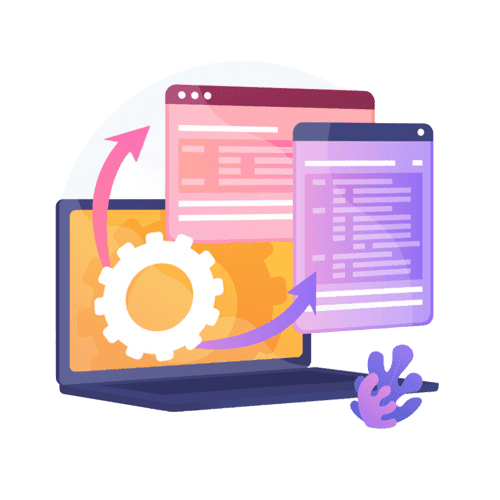[dsm_gradient_text gradient_text="When AI Met ISO 9001" _builder_version="4.27.0" _module_preset="default" header_font="Questrial|||on|||||" header_text_align="center" header_letter_spacing="5px" filter_hue_rotate="100deg"...
Enhancing Business Success Through Effective Traceability: Lessons from Industry
In today’s fast-paced and highly regulated industries, traceability is crucial for maintaining quality and ensuring compliance with safety standards. By effectively implementing traceability practices, companies can track and link project artifacts throughout the product lifecycle, ensuring that customer requirements are met and regulatory obligations are fulfilled. This not only enhances the reliability of products and services but also strengthens the organization’s reputation and competitive edge in the market.

In today’s competitive market, businesses offering services related to ISO standards, IATF standards, VDA standards, and other critical compliance frameworks must prioritize the implementation of traceability in their operational processes. Traceability is the practice of tracking and linking various artifacts, such as requirements, designs, and test cases, throughout the lifecycle of a project. This approach ensures quality, compliance, and accountability, especially in safety-critical domains like medical devices, automotive, and aerospace. Drawing from practical experiences and insights, this blog post discusses the critical importance of traceability and offers valuable lessons for companies providing training, mentoring, consulting, and other services related to these standards.
The Importance of Traceability in Safety-Critical Industries
Traceability has emerged as a cornerstone in industries where safety and quality are paramount. As outlined in the paper Assessing Traceability—Practical Experiences and Lessons Learned, traceability is essential for meeting regulatory requirements and ensuring that software development processes are both effective and efficient. For example, the Food and Drug Administration (FDA) mandates that software requirements are traceable to system requirements and risk analysis results, ensuring that all software codes are linked to established specifications and test procedures. Similarly, traceability is crucial in automotive standards like IATF 16949 and VDA, where it ensures compliance with safety and quality management protocols.
%
defects remaining undetected
According to a study published by the National Institute of Standards and Technology (NIST), poor traceability in software development can result in up to 80% of defects remaining undetected until the testing phase, significantly increasing the cost of fixing these issues by up to 100 times compared to addressing them during the requirements stage.
%
reduction in project overruns
The International Data Corporation (IDC) reports that organizations implementing comprehensive traceability practices see a 20% reduction in project overruns and a 30% decrease in compliance-related incidents, demonstrating the significant impact of traceability on both project efficiency and regulatory adherence.
Barriers to Implementing Traceability
Despite its importance, many organizations face significant barriers to implementing effective traceability. Common challenges include the complexity and cost associated with building and maintaining a requirements traceability matrix, which can be time-consuming and error-prone. Additionally, there is often a lack of awareness and guidance on how to implement traceability, leading to inconsistencies and gaps in the traceability process. These barriers are exacerbated by differing stakeholder perceptions, with some viewing traceability as a means of micromanaging their work rather than a tool for enhancing quality and compliance.
Without traceability, there can be no quality. You can’t manage what you don’t measure, and traceability is the key to understanding and improving every step in the process.
Practical Approaches to Improving Traceability
To address these challenges, companies should consider adopting a structured traceability process assessment model (PAM). The development and validation of such a model, as demonstrated in the case study of two medical device organizations, can identify strengths and weaknesses in an organization’s traceability practices. This assessment framework typically includes evaluating traceability across change management, risk management, and software development lifecycle (SDLC) processes.
Key Strategies for Implementing Effective Traceability
Automate Traceability Processes
Automation can significantly reduce the time and effort required to maintain traceability. Using tools that support the Open Services for Lifecycle Collaboration (OSLC) initiative can streamline the integration of various lifecycle tools and provide dynamic traceability that evolves with ongoing changes.
Adopt Best Practices
Implementing best practices, such as establishing a clear company policy on traceability and developing standard operating procedures, can help institutionalize traceability across projects. Regular training and availability of resources are essential to ensure that staff understand and adhere to these practices.
Leverage Industry-Specific Models
Tailoring the traceability framework to meet industry-specific standards, such as Automotive SPICE for the automotive and medical device sectors, can help align traceability practices with regulatory requirements and best practices.
Regular Assessments and Continuous Improvement
Conducting regular assessments using a traceability PAM allows organizations to identify areas of improvement and make necessary adjustments. This approach not only ensures compliance but also enhances the overall quality and safety of the product.
Conclusion
Effective traceability is not just about meeting regulatory requirements; it is a strategic asset that enhances quality, safety, and customer satisfaction. By overcoming barriers through automation, best practices, and regular assessments, companies can improve their traceability processes, thereby ensuring compliance with ISO, IATF, and VDA standards. This commitment to traceability will ultimately lead to better project outcomes, reduced risks, and enhanced market competitiveness. Whether in training, consulting, or implementation, embracing traceability is a step towards achieving excellence in service delivery and operational efficiency.
Wanna know more? Let's dive in!
Sustainability Through Collaboration Building a Greener Future Together
[dsm_gradient_text gradient_text="Sustainability Through Collaboration: Driving Change Across Industries" _builder_version="4.27.0" _module_preset="default" header_font="Questrial|||on|||||" header_text_align="center" header_letter_spacing="5px"...
Why Sustainable Car Design Matters
[dsm_gradient_text gradient_text="A Comprehensive Exploration of Agile Auditing" _builder_version="4.27.0" _module_preset="default" header_font="Questrial|||on|||||" header_text_align="center" header_letter_spacing="5px" filter_hue_rotate="100deg"...
Cultivating a Quality Culture: Guide to Organizational Excellence
In today’s rapidly evolving global marketplace, organizations across various sectors are recognizing the critical importance of fostering a culture centered on quality. This emphasis is not merely about adhering to standards or regulations but involves embedding quality into the very fabric of an organization’s ethos, operations, and interactions. A robust quality culture ensures that every member, from top leadership to frontline employees, is committed to continuous improvement, customer satisfaction, and operational excellence.
The Hidden Costs of Human Error in Healthcare
Human error is a significant challenge in healthcare, where even minor mistakes can have serious consequences. Unlike other industries, errors in healthcare directly affect human lives, making patient safety a top priority. The increasing complexity of modern healthcare, with its integration of technology and electronic health records, introduces both opportunities and challenges. The need for quality assurance is paramount in reducing human errors and ensuring high standards of patient care.
Consistency in Quality: The Foundation of Total Quality Management
In today’s fast-paced and competitive business landscape, ensuring quality is paramount for survival and success. Concepts such as Total Quality Management (TQM), Lean Manufacturing, and Time-Based Competition have gained prominence as organizations strive to enhance efficiency, reduce waste, and improve customer satisfaction. However, one of the most overlooked yet critical factors for the successful implementation of these quality programs is consistency in quality. Without consistency, even the most well-planned quality strategies may fail to yield the desired results.
Software Engineering Process and Quality Assurance Framework
The automotive industry is experiencing rapid transformation, driven by advances in technology, increasing competition, and evolving customer expectations. To stay ahead in this dynamic landscape, companies must continuously innovate while optimizing costs. One of the most effective strategies for achieving these objectives is outsourcing software development and engineering processes.
Elevating Software Quality in Automotive Engineering
In the ever-evolving landscape of automotive engineering, ensuring high software quality is a key challenge. With the increasing complexity of vehicle functionalities and the integration of advanced driver-assistance systems (ADAS), maintaining stringent quality standards is essential. Volkswagen introduced the Software Quality Improvement Leader (SQIL) initiative to bridge the gap between software quality and supplier collaboration, ensuring the highest standards in automotive software development.
The Future of Batteries: How Organic Batteries Are Changing the Game
Organic batteries are on the rise, offering safer, greener, and cheaper alternatives to traditional batteries. As research progresses, we can expect longer-lasting, flexible, and biodegradable batteries powering our future devices.
Organic Thermoelectrics: Turning Heat into Power
Imagine if you could charge your phone just by wearing your hoodie, or if your laptop could recycle its own heat to power itself. Sounds futuristic, right? Well, organic thermoelectrics are making this a reality! This cool (or should we say hot?) technology is all about using special materials to turn wasted heat into usable electricity.
Flawless Displays: How AI is Revolutionizing OLED Mura Defect Detection
In the rapidly evolving field of display technology, ensuring impeccable screen quality is paramount. Mura defects, characterized by irregular brightness or color variations, pose significant challenges in OLED display manufacturing. Traditional inspection methods often fall short in detecting these subtle imperfections. This comprehensive blog post delves into the innovative application of region-based machine learning techniques for effective Mura defect detection. By exploring the integration of advanced algorithms, dataset generation, and adversarial training, we highlight a robust approach that achieves superior accuracy and efficiency in identifying and classifying Mura defects.
The Future of Innovation: How Industry 4.0 is Driving Sustainable Development
Industry 4.0 is transforming manufacturing and business operations by integrating digital technologies to drive sustainable innovation. This article explores the role of Industry 4.0 in fostering eco-friendly practices, enhancing efficiency, and optimizing resource utilization. A structured roadmap outlines how businesses can leverage Industry 4.0 for long-term sustainability and competitive advantage.












